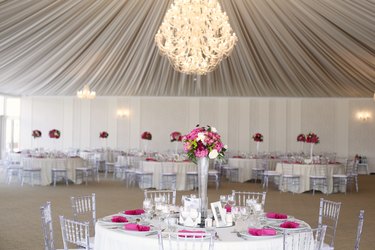Redecorating gives any room a fresh, new look. But if you're renting or on a limited budget, painting or remodeling may not be a viable option. This is especially true with an ugly or outdated ceiling. Fortunately, a measuring tape, a few yards of fabric and a staple gun are all you need to bring a stylish ceiling treatment within your reach.

Choose Your Look
There is not one single right way to cover a ceiling with fabric. You can use the fabric as you would paint for a sleek and fitted look or gather and drape the fabric for a billowy and romantic effect. Dropped ceiling panels can be covered individually, either all with the same fabric or with complementary or contrasting fabrics for a fun and funky patchwork look.
Video of the Day
Video of the Day
A richly-colored or patterned fabric can bring depth and warmth to a large, plain room. Swathes of draped tulle or other soft fabric can soften a room, but is not practical if you have a low ceiling and tall occupants. Covering ceiling panels offers visual interest, but choosing the wrong fabric can result in overwhelming a very small room, so choose your end result with care.
Measure Your Ceiling
Use a measuring tape to measure the width and length of your ceiling. If your room is a cube with no odd angles, you can opt to measure the floor, which is easier. Add six to eight inches to each measurement if you are going for a flat, fitted look. Add two inches per side for each tile if you'll be covering individual dropped ceiling panels. Add two to four feet (or even more) per side if you are going for a draped and flowing look.
Next, multiply the width by the length and this will tell you how many square feet of fabric you will need. Fabric comes in several standard widths—from about 35 to 60 inches for upholstery fabric. To save on money, you can also use drop cloths or bed sheets for your project.
Gather Your Tools
A staple gun is your best friend on this particular project. That, and a second pair of hands if you can find one. Sharp scissors are also a plus, as are duct tape and a ladder. If you are using tulle or another very lightweight fabric, you can use masking tape or painter's tape. Clean socks are a good idea as well if you are covering or draping the entire ceiling, rather than individual panels, because you may have to step on the fabric to cut or gather it.
Install Your Fabric
Lay your fabric out on the floor—printed side down—if you are doing a fitted or draped ceiling. Start in one corner and attach the fabric to the ceiling by placing small pieces of duct tape along the wall. The fabric will drape a bit, but you'll pull it taut later. Once your first strip of fabric is taped up, start back at the first corner, fold one inch or so of the fabric so that you have a clean edge. Staple it to the ceiling where it meets the wall. Place your staples about two inches apart. Go to the corresponding corner and attach the fabric, pulling it taut. This is one step where extra hands are a huge help. Staple this corner as you did the first, then go back and do the long edges of the fabric, pulling off and discarding the duct tape as you go. Repeat until the ceiling is completely covered, making sure to match any stripes or patterns for a more polished and professional look. Use finishing nails to attach molding to the place where the ceiling meets the wall to complete your look.
Lay your fabric out on the floor if you are doing a draped ceiling. Attach the fabric to the center of the ceiling, working around the light fixture if necessary. Staple the fabric to the ceiling and then to each of the four corners. You can leave each piece in one long swoop, or attach it to the ceiling at intervals for a series of swoops. Make sure that you match each swoop to the next or you'll get an uneven effect. Attach molding or fabric trim with fringe, beading or other decorative touches to the place where the ceiling meets the wall for a more finished look.
Cut your fabric into pieces that are at least 3 inches larger than your panels on every side. Place the first piece of fabric on a clean, flat work surface with its printed side down. Take down the ceiling panels one at a time, because they are not always a uniform size, making it hard to reinstall. Center your ceiling panel on the fabric. Fold the edges of the fabric up and over the edges of the panel and secure it with double-sides tape or thin strips of duct tape. Snip the corners to mitre them and avoid bunchy corners. If this will be a permanent change, you can use fabric adhesive to adhere the cloth to the panel by spraying or brushing the adhesive onto the fabric before you center the panel on it. Replace the fabric-covered panel into the ceiling. Repeat until all of the panels are covered, being careful to match the direction of patterns or stripes.